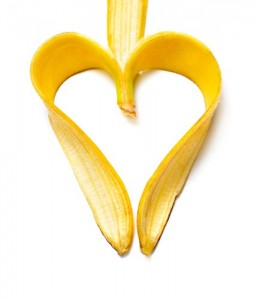I Go Bananas For Curved Yellow Fruit
 Just like everybody else (with the possible exception of the women’s Olympic gymnastics team), I have bad habits. My voice goes shrill when things don’t go my way, for example, and I pick my nose when I think I’m alone. Until about five years ago, I never would have thought that eating bananas could be considered anything but a good and healthy habit, but according to some people it’s as much a vice as smoking Marlboros and betting on horses.
Just like everybody else (with the possible exception of the women’s Olympic gymnastics team), I have bad habits. My voice goes shrill when things don’t go my way, for example, and I pick my nose when I think I’m alone. Until about five years ago, I never would have thought that eating bananas could be considered anything but a good and healthy habit, but according to some people it’s as much a vice as smoking Marlboros and betting on horses.
In her book Animal, Vegetable, Miracle, Barbara Kingsolver describes a year-long challenge to live with her family on a locavore diet on their Virginia farm. Bravely, they swear off luxuries like chewing gum, quick mixes, and produce from outside the state; and in one situation, Kingsolver actually refuses to buy bananas for her daughter’s visiting friend. Since the majority of the bananas we eat grow within 10 degrees of the equator, she reasons, they have to be shipped many miles in refrigerated, gas guzzling trucks, and are are about as un-local as you can get. And any Northeasterner who consumes them is correspondingly unlikable.
But it also turns us into unstoppable powerhouses with horselike strength and stamina. Just one banana in the morning is enough to propel me through a strenuous 90-minute run or bike ride, and the high potassium content prevents cramping and soreness along the way. And thus the simple act of eating a banana has become, for me, a daily moral struggle that always ends the same way: a hollow banana peel tucked shamefully out of sight under the local produce rinds in my compost bin.
How can a food that makes me feel so good be such a devil in disguise? I mean, seriously, bananas must be molded out of raw kryptonite ore. In addition to potassium, they are a great source of dietary fiber, vitamins C and B6, and manganese, and low in saturated fat, cholesterol, and sodium. When I eat one and then go for a run, I feel like I’m on roller skates. And, at about $.65 per pound, they are cheaper (and more natural and legal) than any performance-enhancing drug on the market.
In the interest of finally putting my moral struggle to rest and determining, once and for all, how bad bananas really are for the environment, I did some research. I didn’t have to search very far: amazingly, there is actually a book called How Bad Are Bananas? The Carbon Footprint of Everything by Mike Berners-Lee. I opened the book, bracing myself for an answer I was sure I wouldn’t like, and was surprised to discover that the carbon footprint of a banana is lower than that of a bowl of oatmeal. While Berners-Lee does reveal information that Don Juan De Marco or Pepe Le Pew might not appreciate (store-bought roses for your sweetheart are environmentally worse than driving a mile in your car), he gives bananas an earth-friendly thumbs-up. This is because:
· Bananas grow in natural sunlight, which means that they don’t require energy-intensive hot houses
· They preserve well and provide their own packaging
· Although many of the bananas available to us are grown in monocultures for cheaper yield and rainforests are cleared all the time for banana production, there are plenty of fair trade and organic options that are still cheap
So there you have it. Bananas are generally good, unless of course you fall prey to that old “step on a rotten peel” trick. Set forth, purchase yourself a $.65 pound of potassium, and go charge up a mountain!

